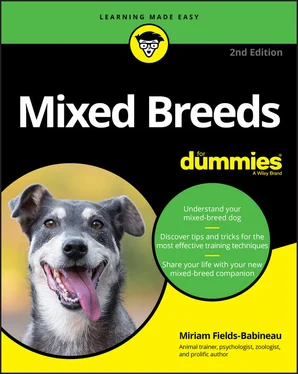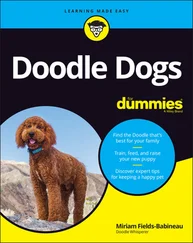2 Sit and stare into the dog’s eyes. Don’t look away first.Possible reactions you may see in the dog include the following:The dog stares back at you and growls. This reaction is one of a very confident, and possibly assertive, dog. This is not a dog you’ll want to live with — she’ll challenge you every chance she gets. If she’s showing assertive behavior at this point, you most definitely don’t want to move on to Step 3. She may just be stressed in her current location, but you have no way of knowing that she won’t be similarly stressed at some point after you bring her home.The dog stares back at you and doesn’t look away. This reaction is still an assertive dog, but one who can be. Doing so will take consistency and diligence, as well as a consistent guardian who will make the dog work for everything. This dog will be happiest in a very structured environment.The dog stares at you a moment and then looks away. The dog who stares and looks away is unsure of her position. She may be testy in specific situations, such as when she really wants something, but she’ll easily back down if her guardian remains assertive and insistent.The dog never looks you in the eye. The dog who never looks in your eyes is very submissive and accepting. This dog will do well in most environments.If you were able to perform Step 2 without the dog showing any aggression, you can give Step 3 a try. If the dog has shown any assertive behavior in the other tests, do not move on to Step 3. Step 3 puts the dog in a totally submissive position where she feels vulnerable.
3 Gently roll the dog over onto her back.Possible reactions you may see include the following:The dog struggles, growls, and tries to bite you. This is the reaction of a very assertive dog. She’s not a good candidate for anyone with children or an active home. She will do best with a single, consistent owner who will work with her and maintain a structured environment.The dog struggles but eventually gives in. This is the reaction of a dog who has some assertive tendencies but who understands when she’s not in charge. She’ll do well in a home with consistent owners, but not with young children.The dog has no reaction and remains on her back without any struggle. This dog will do well in any home. The dog feels comfortable and secure in her environment.The dog gives in quickly, cries, and moves away when released. The dog who gives in but cries and moves away is submissive, possibly fearful. She should live in a quiet home.The dog gives in quickly and remains with you when released. This dog should work well in any home, though she should always be approached in a positive manner and be given lots of praise for everything she does.
I’ll get that! Testing for possessiveness and retrieval ability
You want your dog to play fetch with you, so the mere fact that she runs after the toy is a great sign. Though, you’d really appreciate her bringing the toy back to you so you can throw it again. It’s the give and take that makes the game.
Some dogs have the genetic tendency to play fetch following the rules; other dogs have different ideas. Some dogs would rather just chase the ball and take it elsewhere so that nobody else can play with it. Other dogs think you’re nuts if you think she’s going to chase that thing when she’d rather be sleeping or chewing on a bone.
This test will let you know which tendency is most likely in a dog. There are two parts to this test, and I cover both in the following sections.
The reaction a dog has to this test will depend on the value of the object you give and take away. For example, for some dogs, a squeaky toy might be fun to play with, but a food-filled bone is of higher value, and the dog may not give it up easily.
 Begin this test with a toy of lesser value, such as a stick or rubber toy, and gradually work your way toward something of higher value, like a tasty bone.
Begin this test with a toy of lesser value, such as a stick or rubber toy, and gradually work your way toward something of higher value, like a tasty bone.
To do this test, just give the dog the item. Then gently take the item away, either offering another one in its place or caressing the dog as you take the object so as not to present a threatening situation.
Possible reactions you may see in the dog include the following:
The dog growls. This dog is possessive. This dog is certainly not right for a family with anyone who isn’t persistent and patient, and certainly not for a family with children or elderly residents.
The dog holds the object, but eventually gives it up. This reaction shows a dog who may have some possessive tendencies, but will quickly learn to drop on cue, if given a chance to learn the behavior. This dog will do well in a home with consistent owners, but not with young children, as they have a tendency to pull items from the dog’s mouth, which can cause a negative reaction from the dog.
The dog readily gives up the object or the dog drops the object and runs away. Dogs who have these reactions will work well in any environment, but if the dog does run away, her guardians need to be patient with her, because she has a short attention span.
To do this test, take one of the dog’s favorite toys, and throw it a short distance.
Possible reactions you may see in the dog include the following:
The dog goes after the toy, picks it up, and runs off. A dog who runs off with the toy is possessive. She likes to chase her toys, but she doesn’t want anyone else to share them with her.
The dog goes after the toy, picks it up, and lays down with it. This dog may not be in a playful mood, but definitely wants to possess her toy.
The dog is curious and goes to check out the toy, but then walks away. This dog doesn’t have much interest in the toy. Are you sure you chose a favored toy? If not, try again. If you did choose her favorite toy, this dog is one who just doesn’t like to play fetch, or who is so stressed that playing isn’t in her current itinerary.
The dog doesn’t go after the toy. This dog just doesn’t like toys or doesn’t care about that particular toy. Try additional toys until you get some response. If the dog doesn’t have any response, the dog likely either hasn’t gotten the point of toys or hasn’t found anything that floats her boat.
The dog goes after the toy, picks it up, and returns it to you. This dog is highly interactive and social. She wants to play with you and is a natural retriever. She’ll likely do well in an active environment with children of all ages and people who spend lots of time with her.
Follow the leader: Testing for social skills
This test is important if you have other animals at home or live in an animal-filled neighborhood. The last thing you want to deal with is a dog who is aggressive to other dogs or wants to chase cats.
The only way you’ll be able to do this test is if the dog is currently being housed in a facility where there are other animals. If she’s currently in a foster home, she’s probably already acclimated to living harmoniously with other animals so this test may not be necessary. But it can be useful if the dog is in a shelter or humane society without direct contact to other animals on a regular basis.
Here’s what to do: Walk her by the kennels of the other dogs. Then walk her in the cat area.
Possible reactions you may see in the dog include the following:
The dog goes after any other dog or cat. This is a dog who shouldn’t go into a home with other dogs or cats or into a neighborhood that has many other dogs or cats in close quarters.
The dog only goes after other aggressive animals (those jumping, barking/meowing, or growling/hissing as she goes by). This dog will fight if challenged. Again, not a good candidate in a home with other dogs or cats, or in a neighborhood where other dogs or cats are living or walking nearby.
Читать дальше

 Begin this test with a toy of lesser value, such as a stick or rubber toy, and gradually work your way toward something of higher value, like a tasty bone.
Begin this test with a toy of lesser value, such as a stick or rubber toy, and gradually work your way toward something of higher value, like a tasty bone.










